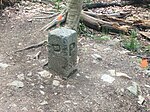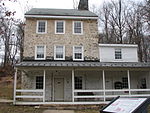Lunn's Tavern

Lunn's Tavern, also known as The Wilkins Property, is a historic inn and tavern located in London Britain Township, Chester County, Pennsylvania. It has three sections. The original section was built about 1760, and is a two-story, stone structure with a gambrel roof. Part of the original section was altered when the brick addition was made in 1830. The modifications included adding stucco to the stone exterior walls and modifying the roof to the gable style. The 1830 brick addition has a wooden porch structure. It was the site of the writing of a famous letter from Thomas McKean to George Read on September 26, 1777, detailing the situation in Delaware and his actions upon assuming the presidency of the State of Delaware.It was added to the National Register of Historic Places in 1979.
Excerpt from the Wikipedia article Lunn's Tavern (License: CC BY-SA 3.0, Authors, Images).Lunn's Tavern
New London Road, London Britain Township
Geographical coordinates (GPS) Address Nearby Places Show on map
Geographical coordinates (GPS)
| Latitude | Longitude |
|---|---|
| N 39.735 ° | E -75.793888888889 ° |
Address
New London Road 1411
19350 London Britain Township
Pennsylvania, United States
Open on Google Maps








